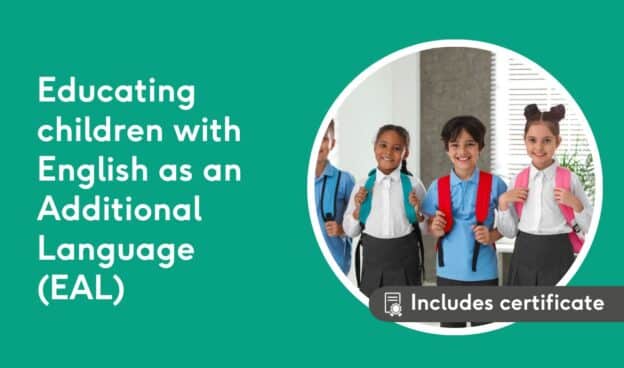Every child has their own learning needs and preferences. Perhaps one of the most apparent barriers can be language. Around 19% of students in UK secondary schools have EAL. Most students catch up with their peers by age 16 but this is not always the case. As educators, we can have a significant impact on these students at every age.
On this short course, we’ll begin by looking at some top tips and practical ideas so you can adapt your teaching to suit the needs of everyone in the classroom, especially those with EAL. Watch the videos, read the text and take the quiz in order to gain your certificate. There is also a helpful document from National Strategy attached which gives more detail on classroom strategies you can adopt.
Supporting children with English as an Additional Language (EAL) requires a thoughtful and inclusive approach to ensure they feel comfortable, confident, and can fully participate in the learning process.
Here are some strategies that teachers can employ:
- Create an Inclusive Classroom Environment:
- Foster a welcoming atmosphere where diversity is celebrated.
- Display multicultural materials in the classroom to reflect the various backgrounds of students.
- Encourage students to share aspects of their culture, language, and traditions.
- Individualised Support:
- Assess each EAL student’s language proficiency level to tailor support accordingly.
- Provide differentiated instruction that meets the individual needs of each student.
- Offer additional support, such as one-on-one or small group sessions, as needed.
- Use Visual Aids:
- Incorporate visuals, charts, and graphs to aid understanding.
- Utilise pictures, diagrams, and other visual cues to enhance comprehension.
- Clear Communication:
- Use clear and simple language when giving instructions.
- Encourage students to ask questions and seek clarification when needed.
- Foster a safe and supportive environment for language exploration.
- Peer Support:
- Encourage peer interaction and collaboration.
- Assign language buddies or partners to help EAL students feel more comfortable in the learning environment.
- Implement cooperative learning activities that promote language development through social interaction.
- Language Development Activities:
- Include activities that focus on language development, such as vocabulary-building games and language-based projects.
- Integrate language learning into various subjects to reinforce academic language skills.
- Cultural Sensitivity:
- Be aware of and respect cultural differences.
- Avoid making assumptions about students based on their language or cultural background.
- Integrate diverse cultural perspectives into the curriculum.
- Regular Assessment and Feedback:
- Regularly assess language proficiency to track progress.
- Provide constructive feedback to guide improvement in language skills.
- Professional Development:
- Attend workshops or training sessions on teaching EAL students.
- Stay informed about effective strategies and best practices for supporting language learners.
- Family Involvement:
- Establish open communication with the families of EAL students.
- Involve parents in their child’s language development and academic progress.
By implementing these strategies, teachers can create an inclusive and supportive learning environment that enables children with English as an Additional Language to thrive academically and socially.
You can watch this first video which gives an overview to EAL. The video shares the stages of EAL to give you an initial understanding. It is created by ‘Little Learners’. The channel is particularly focussed on EYFS and primary education but has many practical resources to help you.


